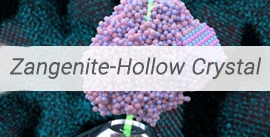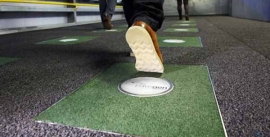 جدید
جدیدآب گازدار در فرآیند تولید گرافن کف میکند! Carbonated water puts fizz into graphene manufacture
آب گازدار در فرآیند تولید گرافن کف میکند!
آب گازدار در فرآیند تولید گرافن کف میکند!
Carbonated water puts fizz into graphene manufacture
محققین در دانشگاه Illinois در اورابانا کاربردی جدید برای آب گازدار در تولید یکی از نازکترین، تختتریت و محکمترین مواد در دنیا یعنی گرافن کشف کردهاند.
——————————————————–
ترجمه از گروه ترجمه ایران مواد
حرفه ای ترین تیم ترجمه مهندسی مواد کشور
———————————————————
با رشد روزافزون کاربردهای گرافن، سرعت و کیفیت تولید آن نیز بایستی توسعه یابد. در همین راستا، گروه پژوهش SungWoo Nam، دانشیار علم و مهندسی مکانیک دانشگاه Illinois ، روشی پاک و دوستدار محیط زیست برای تولید گرافن با استفاده از کربن دی اکسید(CO2) در حالت کربونیک اسید، ابداع کرده است. یافتههای آنها در مقالهای در Journal of Materials chemistry C به چاپ رسیده است.
گرافن به صورت کلی از طریق روش رسوبدهی از فاز بخار(CVD) روی یک زیرپایهی فلزی(معمولا فویل مسی) تهیه میشود. یکی از مراحل دشوار این روش چگونگی جداسازی گرافن بسیار نازک از روی زیرپایهی فلزی به طور سالم میباشد. گرافن بسیار بسیار نازک همچنین نیاز دارد که با یک لایهی محافظ از پلیکربنات یا PMMA(پلی متاکریلات) روی زیرپایه پوشش داده شود که برای این منظور اغلب ملزم به استفاده از حلالهای سمی و سرطانزا هستیم.
در این روش اما از یک زیستتودهی پلیمری به نام اتیل سلولز برای پوششدهی استفاده میشود که یک افزودنی مجاز و ارزان قیمت در مواد غذایی نیز میباشد. پس از آن نیز آنها از کربونیک اسید برای جداسازی لایهای گرافن از زیرپایه استفاده میشود که در واقع به کمک همان عمل کف کردن معمول آب گازدار و نوشابهها که ماهر روز شاهد آن هستیم، این عمل تسهیل شده و به خوبی صورت میپذیرد.
با این امر نه تنها فرآیند انتقال گرافن دوستدار محیط زیست شده بلکه اکنون این فرآیند با انواع مختلفی از مواد پلیمری و بیولوژیکی مانند پلاستیکها و هیدروژلها که توانایی تحمل حلالهای شدید را ندارند، سازگار خواهد بود.
پس از انتقال گرافن نیز کربونیک اسید به راحتی به صورت آب و دی اکسید کربن تبخیر شده و نیازی به شستوشوی اضافی نمیباشد. بنابراین با حذف مرحلهی تکراری شستوشو ما موفق به صرفهجویی آب و زمان خواهیم شد. از طریق جداسازی لایهای گرافن از فویل مسی با استفاده از کربونیک اسید به طور کامل، به جای مصرف و تخریب زیرپایه، قادر به استفادهی مجدد و چندباره از زیرپایه خواهیم بود که منجر به ذخیرهی مواد و صرفهجویی در هزینهها میشود.
با توجه به افزایش روزافزون کاربردهای گرافن ما بایستی به دنبال روشها تولید سلامت، سریع و کمهزینهی آن باشیم. گرافن در حال توسعه بوده و از تولیدات آزمایشگاهی به تولید در مقیاس زیاد و کاربردهای تجاری نیز خواهد رسید که در آن صورت سلامت کارکنان نیز یکی دیگر از مزایای مهم این فرآیند جدید میباشد.
دکتر Nam پدیدآورندهی این روش میگوید: ” اگر شما به دنبال ساخت بهترین ترانزیستورها هستید، بایستی پاکترین و خالصترین موادی که میتوانید سنتز کنید را به کار بگیرید. در اینجا، ما این فرصت را برای شما فراهم کردهایم. علاوه براین بسیاری از افراد در حال تلاشهایی برای اندازهگیری خواص ذاتی دیگر مواد هستند. کار ما کمکی برای آنان نیز خواهد بود.”
جزئیات این پژوهش در مقالهای در ژورنال Materials chemistry C به چاپ رسیده است.
منبع: www.materialstoday.com
مترجم : امیر اشجاری
Carbonated water puts fizz into graphene manufacture
Researchers at the University of Illinois at Urbana-Champaign have discovered a new use for carbonated water in the manufacture of one of the world’s thinnest, flattest and strongest materials – graphene.
As the uses for graphene grow, the speed and quality with which it can be manufactured will be paramount. With that in mind, the research group of SungWoo Nam, assistant professor of mechanical science and engineering at Illinois, has developed a cleaner and more environmentally friendly method to isolate graphene using carbon dioxide (CO2) in the form of carbonic acid. Their findings are published in a paper in the Journal of Materials Chemistry C.
Nam, an expert in the field of two-dimensional materials, is especially interested in using graphene to produce sensors or flexible devices – for instance, a wearable patch that, when placed directly on skin, is so thin and transparent that it isn’t noticeable. Nam currently has projects with industry for making wearable graphene sensors.
Graphene is generally synthesized via chemical vapor deposition onto a metal substrate, typically copper foil. One particularly tricky aspect of this process is how to separate the atomically thin material from the metal substrate for integration into useful devices. At the moment, this typically involves either dissolving away the high-purity metal or delaminating the graphene from the substrate, both of which require the use of harsh chemicals that leave stubborn residues. The ultra-thin graphene also needs to be coated with a support layer of polycarbonate or PMMA (poly methyl methacrylate), which requires the use of often toxic and carcinogenic solvents.
“In our case, we are using a biomass derived polymer, ethyl cellulose, for the coating,” explained Michael Cai Wang, Nam’s PhD student and lead researcher on the project. “A common and inexpensive polymer often used as a food additive, ethyl cellulose is solvated in just ethanol.” They then use carbonic acid to delaminate the graphene from the substrate.
“This not only makes our graphene transfer process more environmentally friendly, it is now also compatible with a variety of polymeric and soft biological materials such as common plastics and hydrogels that would otherwise not tolerate harsh solvents,” added Wang.
“After you transfer the graphene, the carbonic acid simply evaporates away as carbon dioxide and water, which doesn’t require any further rinsing,” Nam noted. “We’re thus saving both water and time by eliminating the conventional need for the repetitive and tedious rinsing process. In using electrolytes such as sodium hydroxide or sodium chloride, for example, the sodium tends to remain on the graphene, which is very difficult to completely get rid of.”
“By delaminating the graphene off from the copper foil using carbonic acid, we are also able to reuse the growth substrate multiple times instead of expending it, realizing significant material and cost savings” Wang said.
“I think scientifically what we are bringing to the community is to really motivate people to think about a cleaner way for making graphene,” Nam said. “We are trying to improve upon the well-established protocols so that industry can easily adopt our techniques. Because a lot of devices are contaminated by these previously used chemicals, it inevitably affects the property of graphene.”
“Graphene is just starting to mature from the laboratory and into commercial applications,” explained Wang. “Once you start large-scale manufacturing, workers’ health is also a major consideration, another benefit of our greener process.”
The group also hopes the scientific community might be inspired by this work to find novel ways to utilize CO2 for practical applications. They envision extending the useful lifecycle of carbon while diverting and mitigating its emission into the atmosphere. Nam believes this method will not only have an impact on the production of graphene, but also provide a green and affordable technique to use for etching and processing other materials as well.
“If you are interested in making the best transistor in the world, you have to have the cleanest, purest material that you can synthesize and transfer,” he said. “Here we provide that opportunity to the community. In addition, a lot of people are trying to measure the intrinsic properties of other materials as well. Our approach will help them do that.”









دیدگاه کاربران